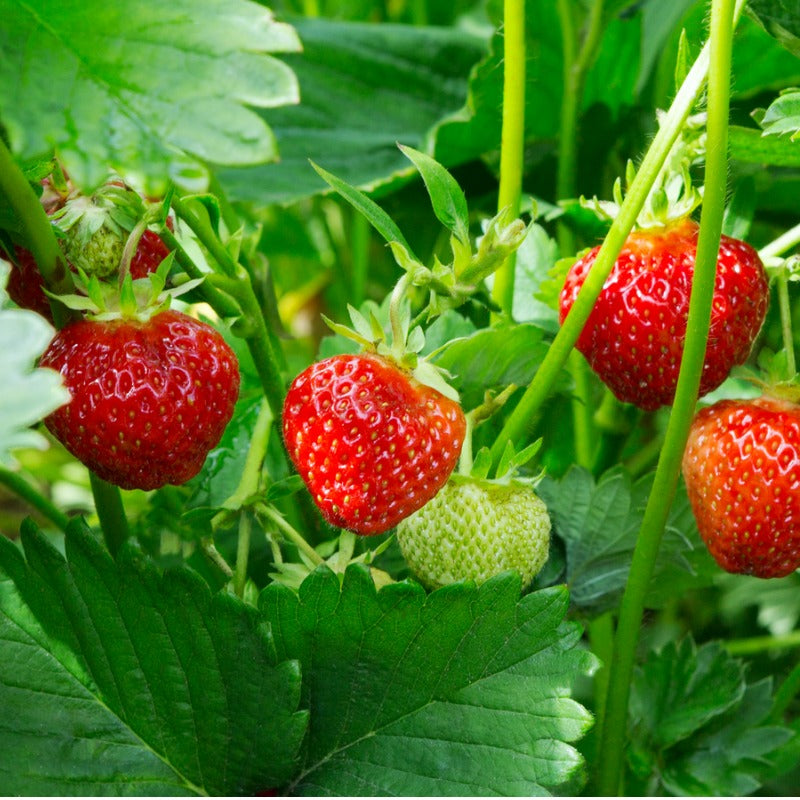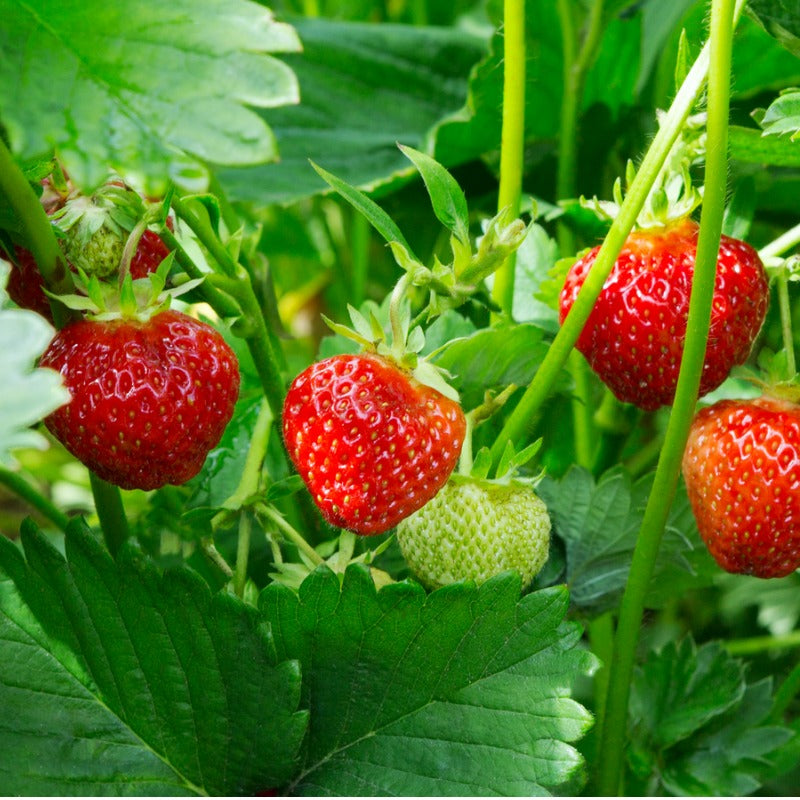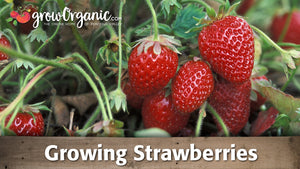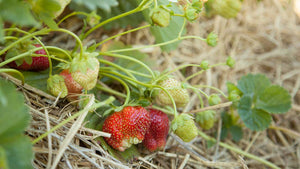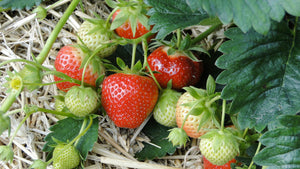Item Number: FV445
Fort Laramie Strawberry Plants (Bundle of Approximately 25)
Fort Laramie Strawberry Plants (Bundle of Approximately 25)
Everbearer Day Neutral
- Everbearer Day Neutral
- Beautiful, large, red fruit with firm, aromatic flesh.
- Winter hardy -- works best in colder areas of USA and Canada (not recommended for Alaska or the South.)
- Eat fresh, freeze, or make jam. Works well in hanging baskets.
- Non-GMO plants
Fort Laramie Strawberry Plants: A Sweet Addition to Your Garden
Strawberries are a beloved fruit, known for their sweet and juicy flavor, vibrant red color, and versatility in culinary applications. Among the various strawberry varieties, the Fort Laramie strawberry stands out as an excellent choice for home gardeners. In this informative article, we will explore the Fort Laramie strawberry plants, their characteristics, and how to cultivate and care for them to enjoy a bountiful harvest of these delectable berries.
Overview of Fort Laramie Strawberry Plants
The Fort Laramie strawberry is a hardy and versatile strawberry cultivar that has gained popularity among home gardeners for its exceptional qualities. These plants are known for their vigorous growth, disease resistance, and ability to thrive in various climates. Here's a closer look at some key features of Fort Laramie strawberry plants:
Hardiness and Adaptability
Fort Laramie strawberries are known for their remarkable adaptability to different climates. They are particularly well-suited for northern regions with cooler temperatures. These plants can withstand frost and are often the first to produce berries in the spring, making them a reliable choice for early-season fruit.
High-Yield Potential
One of the main attractions of Fort Laramie strawberry plants is their high-yield potential. When properly cared for, a single plant can produce an abundance of sweet and juicy berries. A single pound of Fort Laramie strawberry plants, which typically includes around 40 plants, can yield an impressive crop.
Disease Resistance
Fort Laramie strawberries exhibit strong resistance to common strawberry diseases, such as powdery mildew and leaf spot. This disease resistance makes them relatively low-maintenance and ensures a healthier strawberry patch.
Delicious Flavor
The berries produced by Fort Laramie strawberry plants are renowned for their sweet and tangy flavor. They are ideal for fresh consumption, as well as for use in a variety of culinary applications, including jams, pies, and desserts.
Cultivation and Care
Now that we've highlighted the appealing characteristics of Fort Laramie strawberry plants, let's delve into the steps required to cultivate and care for these delightful berries in your own garden.
Site Selection
Choose a sunny location in your garden with well-drained soil for planting Fort Laramie strawberries. Adequate sunlight is crucial for fruit production, and well-draining soil prevents waterlogged roots, which can lead to disease issues.
Planting
Plant Fort Laramie strawberry plants in early spring or late summer to give them ample time to establish before the cold winter months. Space the plants approximately 12-18 inches apart in rows, ensuring good air circulation.
Soil Preparation
Prepare the soil by adding organic matter like compost or well-rotted manure to improve fertility and moisture retention. Maintain a slightly acidic to neutral pH level (around 6.0-6.5) for optimal growth.
Watering
Keep the soil consistently moist, especially during the flowering and fruiting stages. Be cautious not to overwater, as strawberries are susceptible to root rot in waterlogged soil.
Mulching
Apply a layer of mulch around the plants to help retain soil moisture, suppress weeds, and keep the berries clean. Straw, straw, or wood chips are excellent choices for mulch.
Fertilization
Fertilize your Fort Laramie strawberry plants with a balanced, slow-release fertilizer in early spring. Follow the recommended application rates to avoid over-fertilization, which can result in excessive vegetative growth at the expense of fruit production.
Pruning
Regularly remove any runners (long stems) that develop from the plants to encourage energy towards fruit production. Also, prune dead or diseased foliage to maintain a healthy strawberry patch.
Harvesting Fort Laramie Strawberries
Fort Laramie strawberries typically start producing fruit in late spring or early summer, depending on your location. Harvest the berries when they are fully ripe, as they will have the best flavor and sweetness. Gently pick the strawberries by holding the stem between your fingers and twisting to release the fruit.
Fort Laramie strawberry plants offer gardeners a rewarding experience with their adaptability, high-yield potential, disease resistance, and delicious berries. By following the cultivation and care tips provided in this article, you can enjoy a bountiful harvest of these delectable strawberries in your own garden. Whether eaten fresh or used in various culinary creations, Fort Laramie strawberries are sure to be a sweet addition to your gardening endeavors.
For more information, please enjoy our Growing Guide for planting and growing strawberries.


Check Your Zone Compatibility:
Compatible with your zone.
Growing Zone for
,

Our Guarantee To You
Since 1976, we've served our customers at every stage of growing. Please contact us at any time. We are happy to support and assist you.
Description
Description
- Everbearer Day Neutral
- Beautiful, large, red fruit with firm, aromatic flesh.
- Winter hardy -- works best in colder areas of USA and Canada (not recommended for Alaska or the South.)
- Eat fresh, freeze, or make jam. Works well in hanging baskets.
- Non-GMO plants
Fort Laramie Strawberry Plants: A Sweet Addition to Your Garden
Strawberries are a beloved fruit, known for their sweet and juicy flavor, vibrant red color, and versatility in culinary applications. Among the various strawberry varieties, the Fort Laramie strawberry stands out as an excellent choice for home gardeners. In this informative article, we will explore the Fort Laramie strawberry plants, their characteristics, and how to cultivate and care for them to enjoy a bountiful harvest of these delectable berries.
Overview of Fort Laramie Strawberry Plants
The Fort Laramie strawberry is a hardy and versatile strawberry cultivar that has gained popularity among home gardeners for its exceptional qualities. These plants are known for their vigorous growth, disease resistance, and ability to thrive in various climates. Here's a closer look at some key features of Fort Laramie strawberry plants:
Hardiness and Adaptability
Fort Laramie strawberries are known for their remarkable adaptability to different climates. They are particularly well-suited for northern regions with cooler temperatures. These plants can withstand frost and are often the first to produce berries in the spring, making them a reliable choice for early-season fruit.
High-Yield Potential
One of the main attractions of Fort Laramie strawberry plants is their high-yield potential. When properly cared for, a single plant can produce an abundance of sweet and juicy berries. A single pound of Fort Laramie strawberry plants, which typically includes around 40 plants, can yield an impressive crop.
Disease Resistance
Fort Laramie strawberries exhibit strong resistance to common strawberry diseases, such as powdery mildew and leaf spot. This disease resistance makes them relatively low-maintenance and ensures a healthier strawberry patch.
Delicious Flavor
The berries produced by Fort Laramie strawberry plants are renowned for their sweet and tangy flavor. They are ideal for fresh consumption, as well as for use in a variety of culinary applications, including jams, pies, and desserts.
Cultivation and Care
Now that we've highlighted the appealing characteristics of Fort Laramie strawberry plants, let's delve into the steps required to cultivate and care for these delightful berries in your own garden.
Site Selection
Choose a sunny location in your garden with well-drained soil for planting Fort Laramie strawberries. Adequate sunlight is crucial for fruit production, and well-draining soil prevents waterlogged roots, which can lead to disease issues.
Planting
Plant Fort Laramie strawberry plants in early spring or late summer to give them ample time to establish before the cold winter months. Space the plants approximately 12-18 inches apart in rows, ensuring good air circulation.
Soil Preparation
Prepare the soil by adding organic matter like compost or well-rotted manure to improve fertility and moisture retention. Maintain a slightly acidic to neutral pH level (around 6.0-6.5) for optimal growth.
Watering
Keep the soil consistently moist, especially during the flowering and fruiting stages. Be cautious not to overwater, as strawberries are susceptible to root rot in waterlogged soil.
Mulching
Apply a layer of mulch around the plants to help retain soil moisture, suppress weeds, and keep the berries clean. Straw, straw, or wood chips are excellent choices for mulch.
Fertilization
Fertilize your Fort Laramie strawberry plants with a balanced, slow-release fertilizer in early spring. Follow the recommended application rates to avoid over-fertilization, which can result in excessive vegetative growth at the expense of fruit production.
Pruning
Regularly remove any runners (long stems) that develop from the plants to encourage energy towards fruit production. Also, prune dead or diseased foliage to maintain a healthy strawberry patch.
Harvesting Fort Laramie Strawberries
Fort Laramie strawberries typically start producing fruit in late spring or early summer, depending on your location. Harvest the berries when they are fully ripe, as they will have the best flavor and sweetness. Gently pick the strawberries by holding the stem between your fingers and twisting to release the fruit.
Fort Laramie strawberry plants offer gardeners a rewarding experience with their adaptability, high-yield potential, disease resistance, and delicious berries. By following the cultivation and care tips provided in this article, you can enjoy a bountiful harvest of these delectable strawberries in your own garden. Whether eaten fresh or used in various culinary creations, Fort Laramie strawberries are sure to be a sweet addition to your gardening endeavors.
For more information, please enjoy our Growing Guide for planting and growing strawberries.
About Strawberries: Strawberries are extremely adaptable and are grown in every state in the U.S. Plants generally grow 6-8" tall and 12" across, are shallow-rooted, and benefit from mulch such as straw, pine needles, or plastic. Prefer a soil rich in all the basic nutrients with a pH of 6 to 6.5. Susceptible to root rot and must be planted in well-drained soil, with crown set at soil level. Yield under the best of conditions is about one basket per plant per season.
June Bearers generally produce a single large crop in spring to early summer (as early as March in warmer regions) and are prolific producers for 3 to 4 weeks. Pick the blossoms off June bearers the first year to boost production the second year.
Everbearers are not as prolific as June bearers but are especially suitable for growers who wish to harvest a constant supply of berries throughout the summer. Plant some of both to have a large harvest to preserve, and plenty to eat all summer!
Full Box Quantities The plant count of a full box is 1,500. These ship directly from the supplier.
Shipping Information
Shipping Information
Cannot ship to the following states: HI, AK, PR, GU, VI
Cannot ship via SmartPost.
Shipping Weight: 1.75 lb
Dimensions: 6.0"L x 3.0"W x 3.0"H
Features
Features
- Container Compatible
- Good for Beginners
- Long-Lived
- Plant Spreads
- Self-fruitful
- Suited to Cold Climates
- Thornless
Characteristics
Characteristics
Planting & Care
Planting & Care
Useful Information
Useful Information
Guarantee
Guarantee
Limited Dormant Tree & Plant Guarantee
* Claim deadline is June 15th
We guarantee that your dormant tree or plant will arrive in good, viable condition. If your tree arrives in substandard condition, notify us within 3 days of delivery. Please email pictures of the box, inside packaging, the tree and its roots to helpdesk@groworganic.com. We will investigate your claim and process a request to exchange or refund the damaged product.
If your dormant tree or plant has not grown new leaves by June 15th, you may be eligible for our Limited Dormant Tree & Plant Guarantee. This guarantee provides for a store credit for the purchase price of the tree, excluding shipping. Please see the Instructions below.
Important Dates:
- April 1st Dormant trees/plants must be planted in the ground
- May 15th Perform scratch test, if no new leaves have grown
- June 15th Deadline to apply for a dormant tree/plant credit
All required documentation must be received by June 15th for your claim to be considered. Claims or documentation received after June 15th will be denied, without exception. Instructions listed below
Terms and Conditions
We cannot guarantee that your tree or plant will remain alive and healthy after it is received, or bear fruit as there are too many variables in your environment that are beyond our control (i.e. soil preparation, weed and pest control, proper irrigation, chill hours, compatible hardiness for your growing zone, proper choice of pollinator, extreme weather, rodent damage, disease, etc.).
We cannot guarantee that we will be able to provide a replacement tree/plant of the same species either that same growing season or in future years. Customers are responsible for all shipping fees associated with replacement trees and plants.
If we determine that the tree you purchased directly from us is not viable, we will issue you a store credit (not a refund) for the purchase price of the affected dormant tree or plant. Shipping is not included in the dormant tree/plant guarantee. Store credits can be used to purchase any product we sell and are valid for use only until July 1st of the following year.
Historically, 98% of our dormant trees and plants grow and thrive when they have been cared for and planted using our growing guides. Dormant trees and plants must be planted in the ground by April 1st in order to be eligible for credit. If the ground in your area is still frozen solid, you may temporarily plant your tree or plant in a pot.
Potted, non-dormant trees or plants are excluded from this guarantee as they are not dormant at the time of shipment. Evergreen trees such as citrus, avocado and olive trees are not available for credit under the Dormant Tree and Plant Guarantee.
Instructions
We guarantee that your dormant fruit tree or plant will leaf out, if you care for it according to our growing guides. In the unlikely event that your dormant tree or plant does not have leaves by May 15th, follow these simple steps to apply for a store credit:
Before you call or email, please perform a “scratch test” to determine if the tree or plant is still alive. This video shows how to check for live tissue under the bark. Scratch tests need to be done a few inches above and below the graft.
Green Cambium Layer / Living Trees
If the cambium layer under the bark is green, give your tree a little more time. It is still alive, but hasn’t come out of dormancy yet. Check to make sure that it is getting the right amount of deep root water, enough sunlight and that the weather is warm enough for that type of tree/plant to come out of dormancy. Every tree has its own personality and will come out of dormancy at different times. Be sure to submit the required documentation listed below by June 15th, if it doesn’t grow leaves.
Brown Cambium Layer / Dead Trees
If the scratch test shows a brown cambium layer or if your dormant tree/plant doesn’t have leaves by June 1st, please email us at helpdesk@groworganic.com. All required documentation listed below must be received by June 15th for your claim to be considered. To be considered for the guarantee claim, all required documentation must be received by June 15th. Incomplete submissions will be denied.
Required Documentation
- Order number
- Name of dormant tree/plant and the quantity affected
- Photos of each tree or plant showing:
- The roots (tree or plant must be pulled out of the ground)
- The scratch test areas
- The entire tree/plant
We reserve the right to not issue credit for items that have already been replaced. We also reserve the right to require photographic evidence that the tree/plant was not killed by root rot, rodent or mechanical damage.
Share
